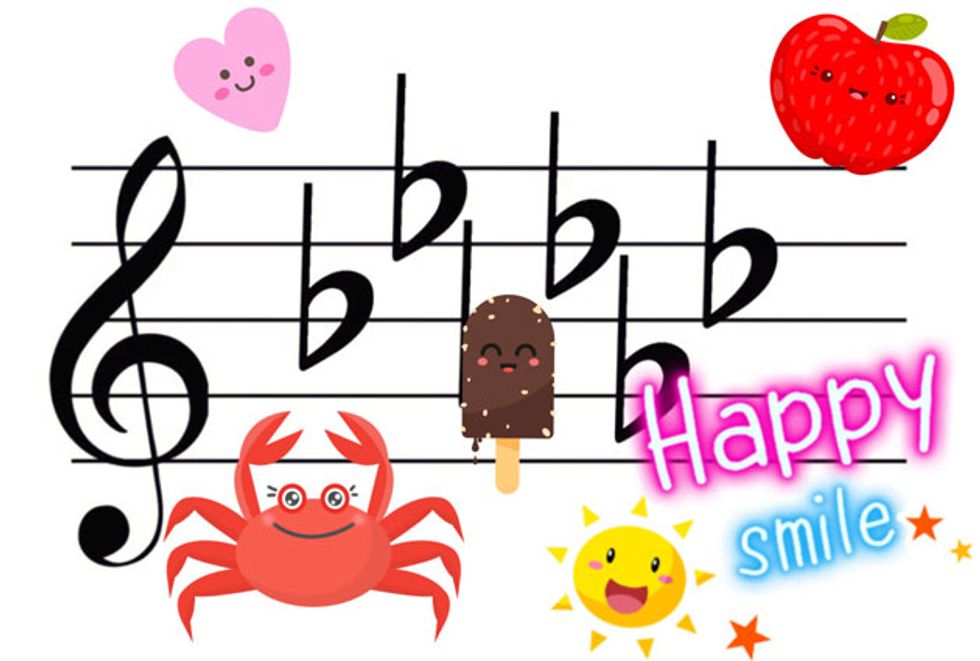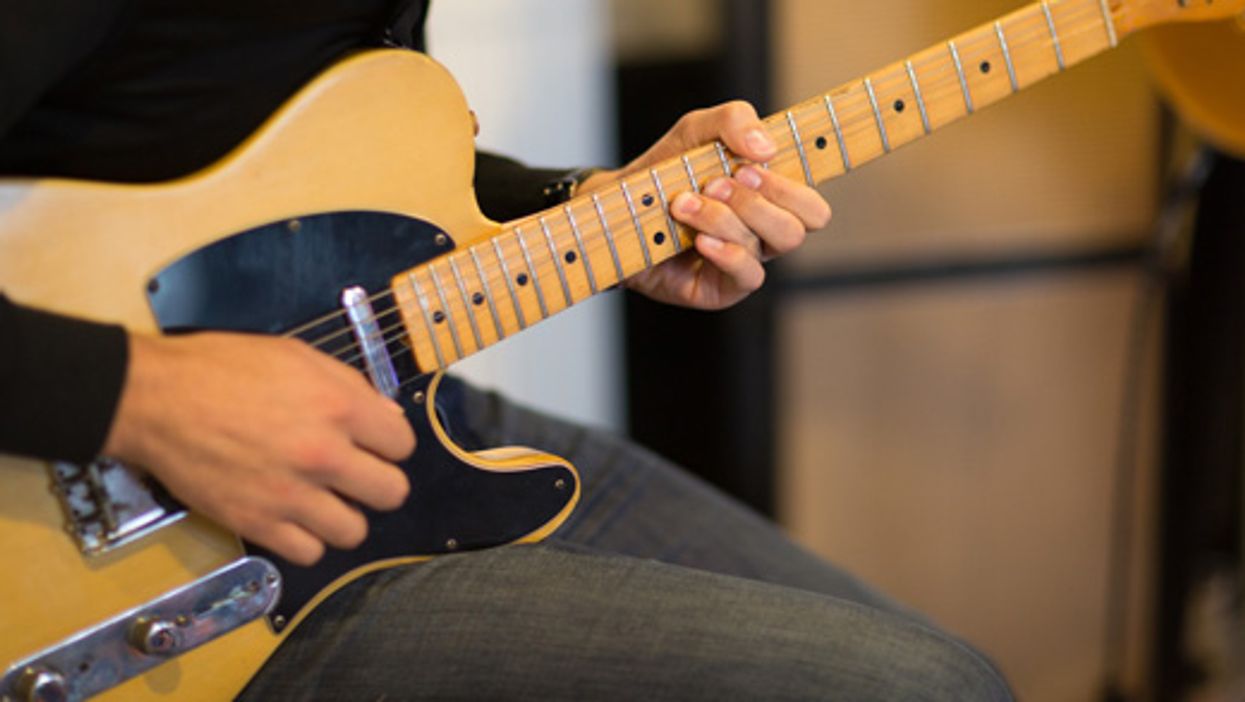Many guitarists hate to play in flat keys. But it doesn’t have to be that way.
Yeah, basic chords tend to be easier in sharp keys than in flat ones, but there’s more to the issue than laziness. In sharp keys, more open strings coincide with scale degrees, making possible rich-sounding chords that combine open and fretted notes. In the keys of C, G, and D (and their relative minors, A minor, E minor, and B minor) all six open strings correspond to diatonic scale degrees. Notice how often open-string notes (indicated in bold) match scale degrees in these keys:
- C major and A minor (no sharps or flats): C–D–E–F–G–A–B
- G major and E minor (one sharp): G–A–B–C–D–E–F#
- D major and Bm (two sharps): D–E–F#–G–A–B–C#
- A major and F#m (three sharps): A–B–C#–D–E–F#–G#
- E major and C#m (four sharps): E–F#–G#–A–B–C#–D#
- B major and G#m (five sharps): B–C#–D#–E–F#–G#–A#
The more sharps, the fewer diatonic open strings. But even in the five-sharp keys of B major and G# minor, you can often let the open 1st and 2nd strings chime out.
Compare that to flat keys:
- F major and D minor (one flat): F–G–A–Bb–C–D–E
- Bb major and G minor (two flats): Bb–C–D–Eb–F–G–A
- Eb major and C minor (three flats): Eb–F–G–Ab–Bb–C–D
- Ab major and F minor (four flats): Ab–Bb–C–Db–Eb–F–G
- Db major and Bb minor (five flats): Db–Eb–F–Gb–Ab–Bb–C
As you can see, there are fewer opportunities to integrate open strings, assuming you avoid relatively dissonant chromatic notes. But if you’re reading this column, chances are you like chromatic dissonance. And that’s where we’re going this month.
Horns Vs. Guitars
Rock guitarists exploring jazz for the first time often run into this issue because many wind instruments favor flat keys by design. For instruments in Bb (including trumpet, soprano sax, tenor sax, and clarinet) and Eb (alto sax and baritone sax) the flat keys are comfy while sharp keys are relatively awkward. You can go to a hundred jam sessions, and you probably won’t meet anyone who wants to play “All the Things You Are” in guitar-friendly G major/E minor rather than the traditional Ab major.
In most pre-1970 jazz, guitarists dealt with flat keys by avoiding open strings, cultivating a piano-like style that makes every key equally approachable. But hey—many of us love the sound of open strings precisely because it contrasts so dramatically with the sound of fretted strings.
Jazz Shmazz
It doesn’t matter whether you play jazz—if you like unexpected notes, you can apply flat-key chromaticism to any musical situation (except ones where you’ll lose the gig if you play outside the box).
Check out Ex. 1, a simple chordal riff using a IV-I progression in the one-flat key of F. (You might also hear this as a I-V progression in the two-flat key of Bb.)
Click here for Ex. 1
Note that I’ve given the simplest possible chord symbols. The first chord in Ex. 1 is called a Bb and not, say, a Bb#4b9. If you think of the chromatic dissonances as passing notes that resolve to simple chord tones, rather than as complex chords in their own right, it becomes easier to experiment with unconventional harmonies.
The open 2nd string—which translates to a #4 (B) scale degree—doesn’t fall within the F major scale, but its crunch sounds cool leading into the C.
Let’s push the envelope. Ex. 2 is in Bb. It uses the open 3rd, 2nd, and 1st strings. The open G note falls within the key. B natural does not—it’s a b2, a crunchy but useful dissonance covered in a previous lesson. The open E is a #4, equivalent to the open E in Ex. 1. In measures 5 and 6, it’s at the center of a thorny chromatic cluster (D#, E, F).
Click here for Ex. 2
Sometimes the b2 can sound vaguely Spanish, like the F natural in all those open-E faux-flamenco licks that sound impressive to non-guitarists. Ex. 3 is in the same spirit—it’s easy to play quickly and sounds trickier than it is. Here, though, we’re in Eb.
Click here for Ex. 3
The open B is the b6, which gives the lick an ambiguous major/minor flavor. The open1st string is our b2.
Rag Mama Rag
Ex. 4 is interesting because it doesn’t sound particularly “outside.” It’s typical fingerpicked ragtime/blues—but in the untypical key of Ab. Here, the open B is a #9 (or b3) leading to C, the 3 in Ab major. Measures 5 and 6 are similar to the corresponding measures in Ex. 2, only here the open 1st string is a b6.
Click here for Ex. 4
Eb major and Eb minor can be sucky guitar keys because the lowest root note is nearly an octave above the open 6th string. Ex. 5 addresses the issue with the 6th string tuned down to D. That way, you can barre across the three lowest strings at the 1st fret while adding open-string chromaticism.
Click here for Ex. 5
This example is in Eb minor—a key with six frickin’ flats! But one of those notes is Cb. (It’s called Cb rather than B natural because the scale already includes a Bb, and the Cb is the 6th scale degree. But however you spell it, the open 2nd string provides it.) Meanwhile, the open 1st string is another b2.
Hidden Opportunities
Flat keys aren’t an occasionally necessary evil for guitarists—they’re an opportunity! They can break you out of the muscle-memory box while generating fresh-sounding, harmonically compelling ideas. Try it and see—and please share your discoveries!



















